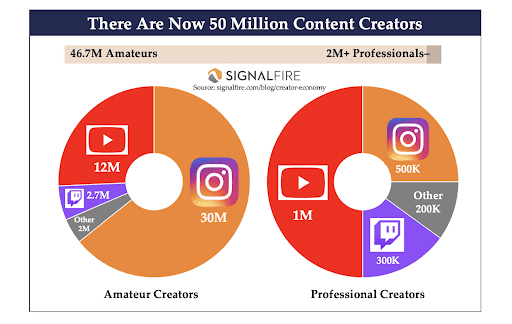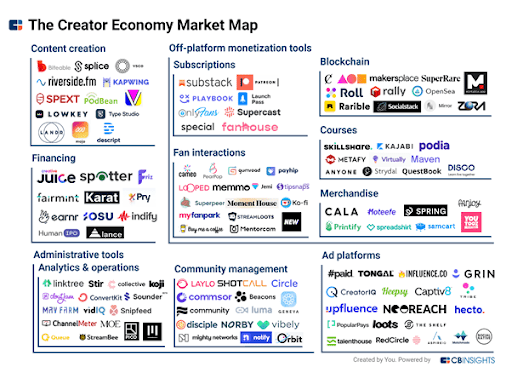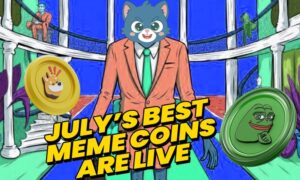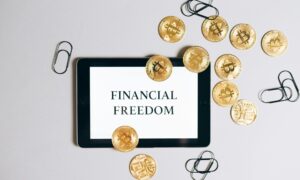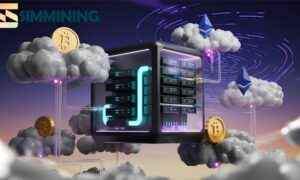You may have heard of the creator economy: a mish-mash of platforms, marketplaces, and tools which allow anyone to create something and monetize it. Put another way, participants in this economy are pairing together creative expression with entrepreneurship. Some might say, “getting paid for doing what they love; living the ultimate dream.”
But while the creator economy today is on the rise — there are now reportedly 50 million participants — not everyone is turning pro. In fact, it has been reported that just 1 in 25 creators class themselves as professionals. These creators are vying for a slice of a rather large $100 billion-dollar pie.
If we take trends and surveys into account, the influx of the workforce into the creator economy is only set to rise. In fact, one survey by travel company First Choice found that of 1,000 children aged 6 to 17 surveyed, the vast majority want to be part of the creator economy, with 75% surveyed noting that they want to become a YouTuber.
And these figures are supported by another survey from Lego which reports that today’s children are three times more likely to aspire to be a YouTuber (29%) than an Astronaut (11%).
So the tabloids have made a big deal about this, but how surprised are you? Children spend much of their time online adoring influencers, whether they be teaching teenagers how to apply makeup or gamers how to win at Fortnite. Moreover, we all understand that these creative idols are making a handsome profit from doing so. Just take Kylie Jenner transforming herself from a teenager with an Instagram following into the world’s youngest self-made billionaire.
So the paradigm shift has become undeniable but for it to keep developing it needs to continue its growth using new tech.
Platforms for the creator economy
As mentioned, YouTube is a massive influence on the creator economy in terms of attracting new participants and the market share it captures. But then again there are newer kids on the block like Patreon and OnlyFans who have been soaring in value using a model different from advertising.
If we take a look at CB Insights map below, we can see that there are a wealth of businesses looking to find their niche to help advance the creator economy.
However, here I want to focus on a new darling and a point of further growth for the creator economy hype: NFTs.
Non-fungible tokens + creator economy
Non-fungible tokens (NFTs) have shot to fame over the past year or so, not least with Twitter founder Jack Dorsey selling his first tweet as an NFT for a cool $2.9M. Not without their critics, NFTs have been heralded as the future of asset trading on the blockchain because they can represent an asset, with proof of ownership that cannot be counterfeited.
The sceptics state that there is no inherent value because they only represent an asset and that asset may be accessible to anyone in the world, just like Jack Dorsey’s tweet. However, if we think about this through a paradigm of vinyl record collectors then we can make better sense of it. I mean, a record can sell for over $40,000, yet the music is freely available online (here I will refrain from comments about quality and subjective value).
So now we’ve established NFTs place in the creator economy, let’s look at where they are traded hands.
NFT marketplaces
NFTs are traded on decentralized markets, meaning that buyers can interact directly with vendors and bypass centralized publishers (i.e. the likes of YouTube) that capture much of the value created by the creation of the asset the NFT represents. The NFTs are sold on the marketplaces in an auction and people vy to win ownership of the collectibles.
The top NFT marketplace recently found itself in the news for all the wrong reasons. An employee at OpenSea was involved in insider trading, whereby he was buying up NFT artworks minutes before they were to be displayed on the front page of the auction listings. Each sale netted him a few thousand dollars.
Here the technology behind NFTs came under fire since the employee cannot be prosecuted under the law as NFT trading is not regulated. However, this just shows how the regulations are lagging behind since the blockchain ledger was used to determine that something was amiss because the ledger records everything immutably. This meant that the person buying the assets for resale could easily be caught.
So while insider trading could be taking place across many of the NFT marketplaces, employees beware.
Another question that maybe we should address is the hype behind all this. Millions of dollars for a code that represents a tweet? You may think people are going out of their minds and I don’t blame you.
Will the hype end?
It really begs the question, what happens when the hype dies down? Will the liquidity flowing into these tokens dwindle into nothingness?
There are those that beg to differ and say that liquidity in NFTs is only set to increase with the possibility of fractionalizing the assets into F-NFTs (fractionalized non-fungible tokens). Niftex is one of the earliest of these fractional NFT platforms, allowing users to mint their own fractionalized NFTs.
One example of how this might be true is the Doge meme NFT. It originally sold for $4 million but is now speculated to be worth $220 million after being fractionalized into 17 billion pieces.
Another project goes even further, believing that F-NFTs represent the intersection of the creator economy and decentralized technologies. DEIP is creating Web3 infrastructure to increase liquidity flowing to creators via DeFi loans based on creations transformed into NFTs and then fractionalized.
The idea behind this might not be as crazy as it sounds. Companies have been fractionalizing their value for centuries through the issuance of shares and then increasing liquidity further by fractionalizing the shares they’ve already issued. Now decentralized technologies are allowing people to do this with ideas and creative expression.
The growth of the creator economy and influx of liquidity might just be unstoppable for the foreseeable future.


